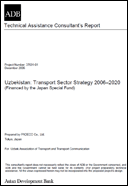Railways
In 2005 Uzbekistan had 3,950 km of rail lines, about 620 km of which were electrified. A large percentage of the system’s track requires major repair. The main line is the portion of the Transcaspian Railroad that connects Tashkent with the Amu Darya. There are rail links with Kazakhstan, Kyrgyzstan (see Trans-Caspian Railway), Tajikistan, Afghanistan, and Turkmenistan.
The most recent projects is the Tashkent-Samarkand high-speed rail line.
The Tashkent Metro is the only such line in Central Asia.
Highways
In 2005 Uzbekistan had 84,400 km of roads, about 72,000 km of which were paved. The road infrastructure is deteriorating, particularly outside of Tashkent. No significant highway projects were underway in 2006. In the early 2000s, U.S. engineers improved some roads around the port of Termez to facilitate movement of humanitarian supplies to Afghanistan. Uzbekistan is a member country of the United Nations’ Asian Highway Network, and several national roads are designated as part of the network.
Ports and waterways
Landlocked Uzbekistan has no seaports. Its main river port is Termez on the Amu Darya river. Although Termez lacks modern facilities and has a shortage of spare parts, activity there has increased as conditions in neighboring Afghanistan have stabilized. Termez has been an important transfer point for humanitarian supplies entering Afghanistan.
Uzbekistan has 1,100 km of inland waterways. Since the mid-1990s, commercial travel on Uzbekistan’s portion of the Amu Darya has been reduced because of low water levels.
Airports
In 2006 Uzbekistan had 34 airports with paved runways, six of which had runways longer than 3,000 m. The largest of them, at Tashkent, is linked with European and Middle Eastern cities by direct flights of Aeroflot, Lufthansa, Transaero, and Turkish Airlines, and with New York and Los Angeles via connecting flights through Moscow. The national airline, Uzbek Havo Yollari (Uzbekistan Airlines), flies mainly within the former Soviet Union. Fuel shortages often disrupt flight schedules from Uzbekistani airports.
Pipelines
In 2006 Uzbekistan had 9,594 km of natural gas pipelines, 868 km of oil pipelines, and 33 km of pipelines for refined products.


